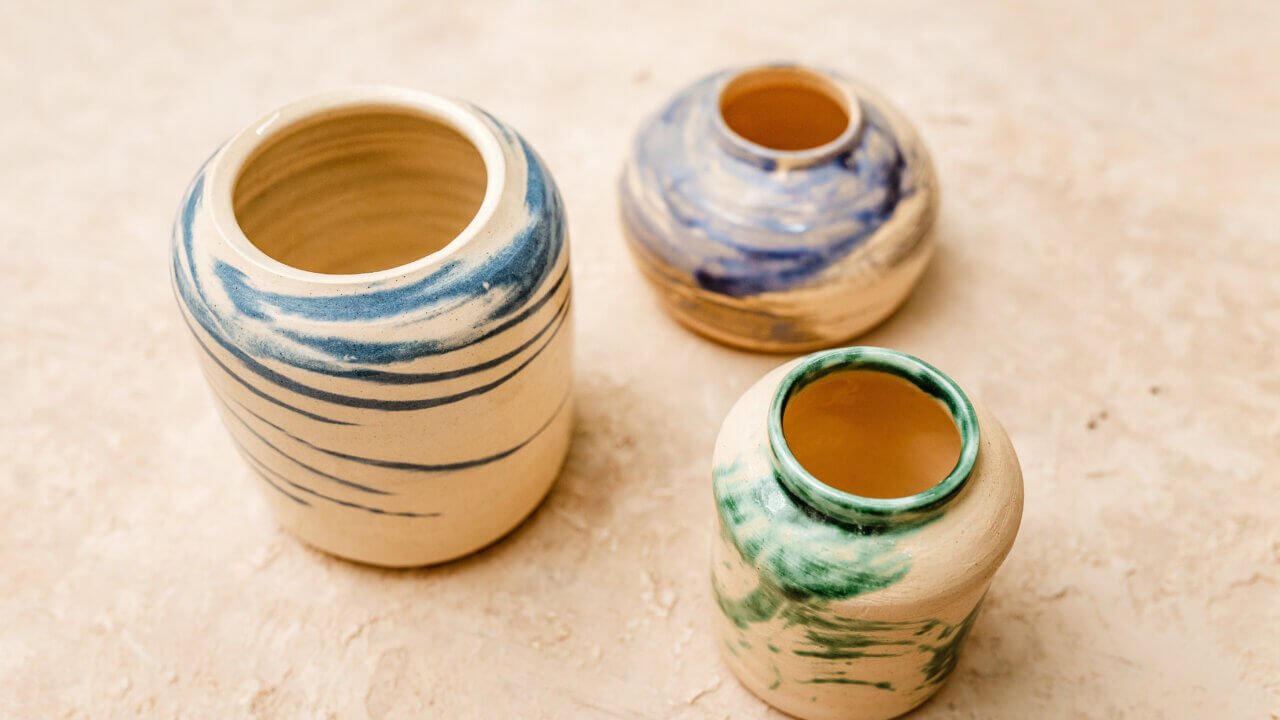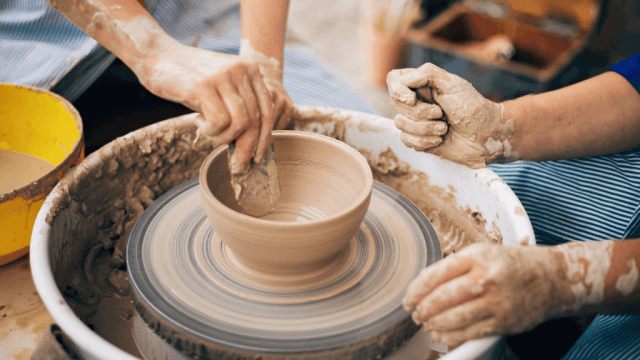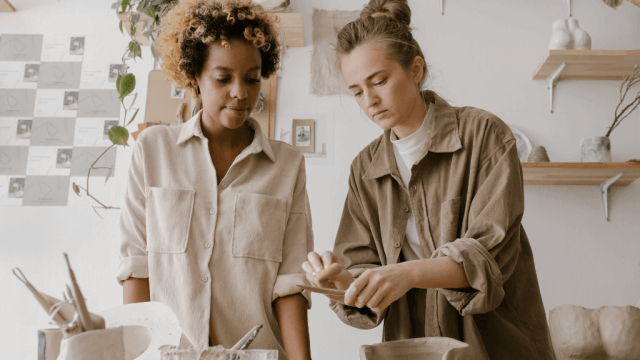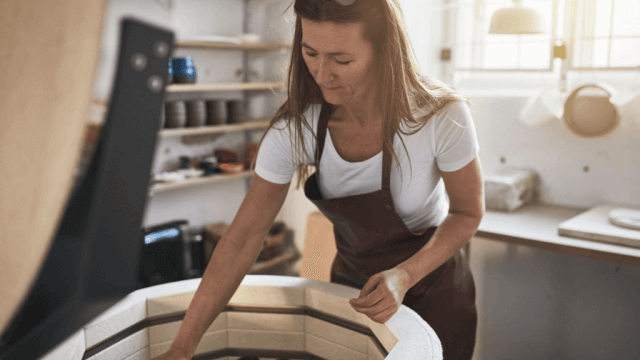To start pottery at home, follow these steps: 1) Acquire essential tools and materials, including clay, a potter’s wheel, kiln, carving/sculpting tools, and glazes. 2) Set up a dedicated workspace with proper ventilation and storage. 3) Learn the basics of pottery, including wedging clay, centering on the wheel, and forming shapes. 4) Practice shaping the clay consistently and develop your skills. 5) Dry, bisque fire, glaze, and glaze fire your completed pieces. 6) Connect with online or local pottery communities for support, resources, and inspiration.
Setting Up a Pottery Workspace at Home
Creating a functional pottery space at home is essential for your creative journey. Consider factors such as proper ventilation, storage, and organization. Ensure you have easy access to water and a space to clean your materials.
Ventilation
Good airflow is crucial for maintaining a healthy working environment. Ensure your space has windows or a fan for proper ventilation to dissipate clay dust and fumes from glazes and kilns.
Storage and Organization
Keep your tools and materials organized with shelves, racks, or drawers. Designate storage areas for clay, finished work, and bisque-fired pieces.
Gathering Essential Pottery Tools and Materials
Before starting pottery at home, gather the following essential tools and materials:
- Clay – Pick a type suitable for your projects and skill level.
- Potter’s Wheel – Choose a manual or electric wheel for hand throwing.
- Kiln – Invest in a home kiln (electric or gas-fired) to fire your pottery.
- Carving and Sculpting Tools – Acquire various tools for shaping, trimming, and carving your clay.
- Glazes – Purchase a variety of premade glazes or create your own with raw materials.
Mastering the Fundamentals of Pottery
Develop your core pottery skills by mastering the following techniques:
Wedging Clay
Prepare your clay by kneading it to remove air bubbles and achieve a uniform consistency. This process is called wedging.
Centering on the Wheel
Place a ball of wedged clay on the potter’s wheel and learn to center it using even pressure from your hands. This is crucial for shaping your pottery.
Forming Shapes
Practice opening the centered clay and pulling up the walls to create various forms such as bowls, vases, and mugs. Work on consistency and control.
Firing and Glazing Your Pottery
After creating your pottery, follow these steps for firing and glazing:
- Dry your pieces thoroughly to prevent cracking during the firing process.
- Bisque fire your pottery to a specific cone temperature in your kiln. This initial firing hardens the clay and makes it porous for glazing.
- Apply glazes to your bisque-fired pieces by brushing, dipping, or pouring. Experiment with different colors and techniques to achieve your desired look.
- Glaze fire your pieces in the kiln, following the recommended temperature and schedule for your chosen glazes. After cooling, your pottery is complete.
Connecting with Pottery Communities
Connect with online or local pottery groups for support, resources, and inspiration. Share your work, ask questions, and learn from fellow enthusiasts to grow in your pottery journey.
Choosing Your Clay
Selecting the right clay type is essential for your pottery practice. Different types of clay have their own unique properties and may be suitable for various experiences and projects. Common types of clay include earthenware, stoneware, and porcelain. Research and consider factors such as firing temperature, color, and workability before making a decision.
Selecting a Pottery Wheel
The potter’s wheel plays a significant role in hand throwing. Choose between a manual kick wheel or an electric wheel. Kick wheels are traditional, require more effort, and can provide better control, while electric wheels offer speed control and ease of use. Assess your space, budget, and preferences before purchasing a wheel.
Kiln Safety and Maintenance
Proper maintenance and safety are crucial when using a kiln. Follow the manufacturer’s guidelines and recommendations for installation, usage, and maintenance. Ensure you have a fire extinguisher and a smoke alarm near your kiln area. Regularly inspect your kiln for any worn or damaged components and make necessary replacements.
Experimenting with Handbuilding Techniques
In addition to wheel throwing, explore various handbuilding techniques like coiling, pinching, and slab construction. These methods can help you create a wide range of pottery pieces and offer a unique creative experience. Experimenting with handbuilding techniques can also support your overall pottery skill development.
Learning Surface Decoration Techniques
Discover diverse surface decoration techniques that will add character and depth to your pottery. Techniques such as sgraffito, slip trailing, inlay, stamping, and carving can significantly enhance your pieces. Learning different ways to decorate your pottery will amplify your personal style and make your work unique.
Storing and Recycling Clay
Proper clay storage is essential for preserving its quality and workability. Keep unused clay wrapped in plastic or in an airtight container to prevent drying out. Recycle clay scraps and trimmings by letting them dry, then add water to rehydrate them, and wedge them back to a workable consistency.
FAQ: Starting Pottery at Home
In the following section, we answer some common questions related to starting pottery at home. These will provide additional clarity and help guide you in your pottery journey.
Do I need a kiln to start pottery at home?
While a kiln is essential for firing and completing pottery, you can begin learning pottery techniques without one. If you don’t have a kiln, consider reaching out to local pottery studios or schools that might provide firing services for a fee.
Is wheel throwing the only way to make pottery?
Wheel throwing is one of several methods for creating pottery. Handbuilding techniques such as coiling, pinching, and slab construction are alternative ways to create pottery pieces at home without a potter’s wheel.
Can I make pottery at home without a dedicated space?
Although having a dedicated space is ideal for pottery, you can still practice some aspects of the craft in a limited space. Handbuilding techniques or tabletop pottery wheels can be used in a smaller area. However, proper ventilation and storage are still important considerations.
How do I decide which type of clay to use?
Selecting the right clay depends on factors such as firing temperature, workability, and your project’s requirements. Research different types of clay, such as earthenware, stoneware, and porcelain, to determine which suits your preferences and needs best.
Is it safe for kids to start pottery at home?
Pottery can be a safe and enjoyable activity for kids, as long as they are supervised and follow proper safety measures. Many handbuilding techniques are kid-friendly and can be practiced without access to a pottery wheel or kiln. Consider using air-dry or oven-bake clays for child-friendly projects.











